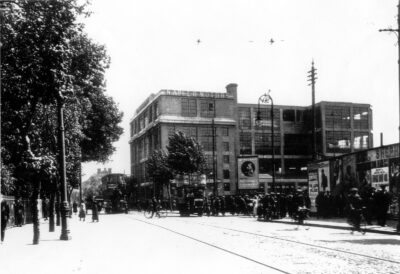ACTON 1
The Acton area always had one of the largest concentrations of industry in the South East of England. In the early 1900’s heavy industry like D Napier & Son moved to Acton because it was (then) on the outskirts of London with room to expand. The two main areas were Acton Vale and Park Royal where The Vale became known as Motor Town after WW1 due to the proliferation of automobile companies including, of course, D Napier & Son Ltd.
During 1900 and 1901 the Napier Lambeth works was only producing cars on a relatively small scale. Car production took off from 1902 so it must have quickly become apparent to Montague that the Victorian works in Lambeth was too small. It had served his grandfather and father well however these premises were no longer going to be sufficient. At this time early motor car makers generally assembled parts bought in from motor factors but David Napier also took the decision to manufacture all of the essential parts in his own works. This ensured that standards were maintained and parts were readily available however it also require space. The outskirts of London had been developing rapidly throughout the Victorian period, with green fields giving way to industry, supported by a well-developed road and railway network. One such area was Acton, in North West London. In 1902 David purchased an initial 3 ¾ acres of land in Acton Vale, on the south side of the Uxbridge Road.
Construction work commenced immediately on a stone-faced brick factory to meet the growing demand for Napier cars. The site also included a grand office block designed by the architect Robert Thompson which included a fine foyer suitable for displaying Napier cars and named ‘Piccadilly Circus’ by many of the staff. The new workshops were better arranged for production of the vehicles than Lambeth. The site also had facilities for internal combustion engine design, manufacture and testing. Whilst some of the most accurate machine tools were brought from the old Lambeth Works most of the tools were new.
By 1904 there were some 500 people employed at Acton, a number that was set to triple over the next few years, necessitating the purchase of further land for the continued development of the works. In 1916 a new concrete office block was constructed and named the Eastman Building. It faced on to Acton Vale and still stands there today albeit refaced in glass and used as an Access storage facility. As further Napier sites were developed around the area this original site was named Acton 1. There was also a Napier office known as Acton 2 and located above the Stewart & Ardern showroom and Morris Motor Works site. Further north were the PR1 Coronation Road Test Tunnels at Park Royal along with Development Test Houses, Investment Foundry, Blade Shop and Apprentice School all know as PR2.



